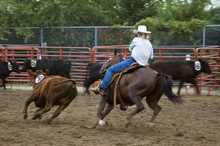With the 2013 show season winding down, now is the time to begin planning to improve in-the-ring safety for 2014, advises HorseSafetyUSA.com.

Safety protocols to protect riders and horses
With the 2013 show season winding down, now is the time to begin planning to improve in-the-ring safety for 2014, advises HorseSafetyUSA.com.
“We all have a tendency to ‘let down’ a bit after the show season ends,” notes Wayne G. Hipsley, chairman of HorseSafetyUSA.com. “Now is the time, however, that memories are the freshest in reviewing incidents that may have been prevented or the negative outcomes greatly reduced.”
For instance, Hipsley asks, does your show have an in-the-ring protocol as to who is in charge in the event of a rider or horse injury? At a recent show, during two different classes, a rider was injured. The first responder? The photographer.
“The ringmaster should be designated as the person in charge and trained to be the decision maker in all emergencies. He or she usually has a radio in hand and can make the call,” Hipsley recommends.
In addition, he recommends that a golf cart or some other style vehicle that is easily maneuvered be designated as the Ring Emergency Vehicle. “Every show should have EMTs on the grounds in event of an emergency,” he observes. “But they will certainly not be the first on the scene, and may not always respond immediately. That’s where a golf cart, pre-stocked with emergency supplies – and an in-the-ring decision tree protocol – come into play.”
HorseSafetyUSA.com has developed recommendations for a “Horse Emergency Response Kit” to be assembled in advance and available at each competition venue in event of an emergency. In addition to basic First Aid items, the “Horse Emergency Response Kit” should contain the following:
- Laminated list of all emergency telephone numbers and ”tree” protocols
- Lead ropes
- Halters
- Lariat
- Knives
- Fence tools
- Plastic tarps for privacy curtains
- Leather gloves
- Leg bandages
- Duct tape
- Blindfold
All of these items can be stored in a single ‘duffle bag’ for easy storage and transport in case of an emergency.
In the case of natural trail horse courses, cross-country events, steeplechase and open hunt courses, an equipped cart should be stationed at each fence/obstacles or cluster of fences/obstacles, making access convenient and response time minimal.
During the non-show months, show managers and show secretaries, who also double as the show manager, need to list the risks their competitors may be exposed to during a competition. The list to review can include some of the following:
1. Signage about wearing safety protective equipment while mounted, required and optional
2. Signage about the state’s Equine Liability Act with notice to participants
3. Poor footing – uneven surfaces, too deep, too hard, too dusty
4. Unsafe arena fencing – either too low or in need of repair
5. Obstacles for trail courses
6. Poorly constructed jump equipment – unsafe jump cups, standards
7. Vehicular traffic patterns and parking
8. Pedestrian traffic – control and access
9. Golf cart - parking and control over licensed drivers
10. Bicycles and mopeds – access and parking
11. Dogs – forbidden or leash enforcement
12. Wash racks with proper footing and drainage
13. Stall maintenance – doors secure, sharp objects removed
14. Access and egress gates – to prevent horses escaping from the property
15. Lighting for the competition venue and night access
16. Add a weather radio to the list of equipment to have available for the 2014 show season
Additionally, show management needs to prepare their risk management strategies from the list of potential risks associated with the event. The emergency strategy planning would include information on how to handle emergencies such as an injured competitor, down horse.
By preparing an emergency plan with the steps to follow and person(s) to contact, show management will save agony and stress when responding to an emergency. And by having an emergency plan, the time responding to an emergency can be shortened perhaps life saving minutes.
“Remember,” Hipsley concludes, “as show management there is a standard level of responsibility that must be met to insure competitor and visitor safety regardless of the state’s equine liability act and competition insurance.
To ignore known risks can be labeled as negligence, which increases the opportunity for risk and jeopardy to the event organizer and show management.”
A recognized national and international equine safety professional for nearly 25 years, Hipsley is the lead author along with of the upcoming publication Equine Risk Management & Safety. The manual is the first volume in The Equine Safety Library to be offered by HorseSafetyUSA.com in both e-book and softbound editions.
HorseSafetyUSA.com, founded in 2011, is dedicated to improving the safety of all aspects of the professional and amateur levels of the equine industry and equestrian sports through education, training, certification, and accreditation.
